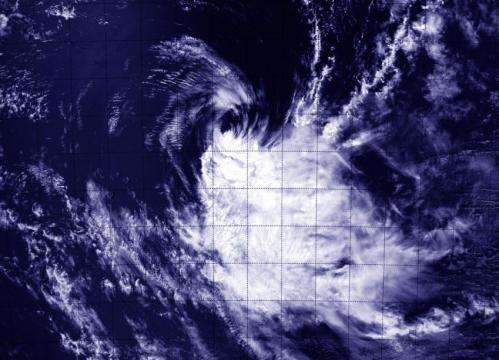NASA sees Tropical Cyclone Kate meeting its end

NASA's Aqua satellite passed over Tropical Cyclone Kate on Dec. 31 and took an image of the storm that showed how wind shear had ripped it apart.
When NASA's Aqua satellite flew over Kate on Dec. 31 at 0800 UTC (3 a.m. EST), the MODIS instrument aboard took a visible picture of the storm. The MODIS image clearly showed that wind shear had pushed the thunderstorms that make up the tropical cyclone, south of the center leaving the northern and eastern quadrants of the storm almost devoid of clouds. Northeasterly wind shear had increased quickly and had taken the storm from a hurricane to a minimal tropical storm in 12 hours.
At 0300 UTC on Dec. 31 (10 p.m. EST on Dec. 30), Kate was hurricane strength with maximum sustained winds near 85 knots (97.8 mph/157.4 kph). Twelve hours later by 1500 UTC (10 a.m. EST), Kate's maximum sustained winds had dropped to just 35 knots (40 mph/62 kph). At that time Kate was centered near 20.9 south latitude and 85.5 east longitude, about 815 nautical miles (937 miles/1,509 km) southwest of Cocos Island, Australia. Kate was moving to the west-southwestward at 11 knots (12.6 mph/20.3 kph).
The Joint Typhoon Warning Center (JTWC) issued their final bulletin on Kate at 1500 UTC (10 a.m. EST). The JTWC forecast discussion noted "Animated multispectral satellite imagery shows the low level circulation center has unraveled and become fully exposed as the central convection has greatly eroded and sheared southwestward. Upper level analysis indicates the system has drifted into the mid-latitude westerlies into an area of strong vertical wind shear."
In addition to the increased wind shear, Kate moved into waters cooler than the 26.6 C/80F needed to maintain its strength. Cooler waters and increased wind shear are expected to cause Kate to dissipate by January 1, 2015.
Provided by NASA's Goddard Space Flight Center





















